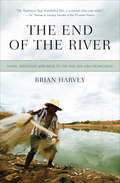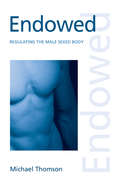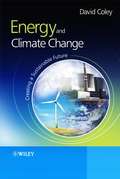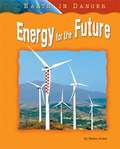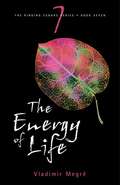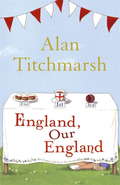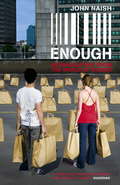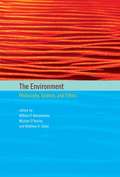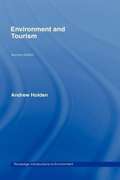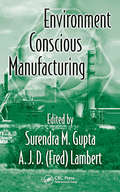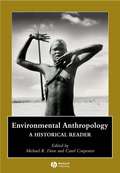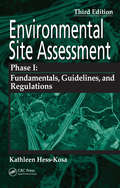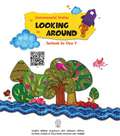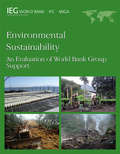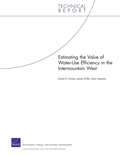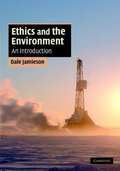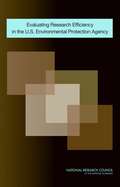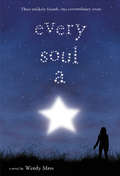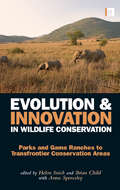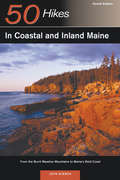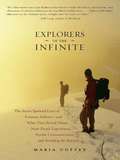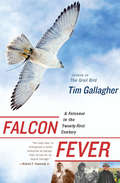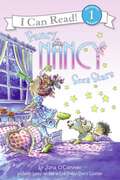- Table View
- List View
The End of the River: Dams, Drought and Déjà Vu on the Rio São Francisco
by Brian Harvey“[Harvey] may have created a new literary genre: science travel writing . . . travelogue, autobiography, history, and even fantasy romp alongside the biology” (Quill & Quire). When biologist Brian Harvey saw a thousand fish blundering into a Brazilian dam, he asked the obvious: What’s going to happen to them? The End of the River is the story of his long search for an answer. Harvey takes readers from a fisheries patrol boat on the Fraser River to the great Tsukiji fish market in Japan, with stops in the Philippines, Thailand, and assorted South American countries. Finally, in the arid outback of northeast Brazil, against a backdrop of a multi-billion-dollar river project nobody seems to want, he finds a small-scale answer to his simple question. In recounting his journey, he populates his story with characters both real and imagined, human and otherwise—a six-foot endangered catfish; a Canadian professor with a weakness for Thai bar girls; a chain-smoking Brazilian with a passion for her river; a drug-addled stick-up artist. The End of the River is about fishermen, fish farmers, and fish cops; there are scientists and shysters as well as a few Colombian narcotráficos and some very drunk, very hairy Brazilian men in thongs. From the founder of the World Fisheries Trust, Harvey introduces a new kind of writing about the environment, as far off the beaten track as you can get in a Land Rover driven by a female Colombian biologist whose favorite expression is “No hay via!”—meaning, “no road!” “[A] freewheeling and vividly written essay on the mysteries and longings of what it is to be human in a world of cynicism and loss—and more significantly, what it is to be hopeful, to persevere, in the search for redemption and beauty . . . A brilliant and instructive book . . . recalls the travel writing of one of Harvey’s heroes, Sir Richard Burton.” —The Globe and Mail (Toronto)
Endowed: Regulating the Male Sexed Body
by Michael ThomsonFeminist legal scholars and health care lawyers have long engaged with law’s responses to the female reproductive body, especially on what the legal regulation of women’s reproductive lives can tell us about the broader relationship between law and gender. Acknowledging this work and building upon it, Endowed considers the interaction of law and ideas of male reproductivity. In particular, it seeks to uncover what these regulatory moments can tell us about contemporary ideas and ideals of masculinity and the male sexed body. Spanning topics such as male circumcision and the regulation of state access to Viagra, the book uncovers recurring motifs that define masculinity and the male body in the legal imagination. In looking to these understandings the book engages with broader questions regarding the relationship between law and gender and between masculinity and social organization.
Energy and Climate Change
by David ColeyFor more information on this title, including student exercises, please visit , http://www.people.ex.ac.uk/DAColey/Energy and Climate Change: Creating a Sustainable Future provides an up-to-date introduction to the subject examining the relationship between energy and our global environment. The book covers the fundamentals of the subject, discussing what energy is, why it is important, as well as the detrimental effect on the environment following our use of energy. Energy is placed at the front of a discussion of geo-systems, living systems, technological development and the global environment, enabling the reader to develop a deeper understanding of magnitudes.Learning is re-enforced, and the relevance of the topic broadened, through the use of several conceptual veins running through the book. One of these is an attempt to demonstrate how systems are related to each other through energy and energy flows. Examples being wind-power, and bio-mass which are really solar power via another route; how the energy used to evaporate sea water must be related to the potential for hydropower; and where a volcano's energy really comes from.With fermi-like problems and student exercises incorporated throughout every chapter, this text provides the perfect companion to the growing number of students taking an interest in the subject.
Energy for the Future (Earth in Danger)
by Helen OrmeBurning fossil fuels, such as oil and coal, may be accelerating Earth's climate change. How can we develop clean, renewable sources of energy and reduce our dependence on fossil fuels? Energy for the Future clearly presents the pros and cons of alternative energy sources-- from wind, water, and solar power to bio-fuels, hydrogen fuel cells, and nuclear power. A section in the back of the book will inspire young environmentalists by suggesting ways they can help protect their planet.
The Energy of Life (The Ringing Cedars Series #7)
by Vladimir Megré John Woodsworth Leonid SharashkinMan's life! On what or on whom does it depend? Why do some become emperors or regimental commanders, while others are obliged to fend for scraps at garbage dumps? One opinion holds that each person's fate is pre-determined from birth. That would make Man nothing more than an insignificant cog in some mechanised system, and not the highly organised creation of God.
England, Our England
by Alan TitchmarshAn anthology and miscellany of everything an Englishman should know: From Austen to Wordsworth,Jerusalem to the Scout?s Honour, Kings and Queens of England to Land of Hope and Glory, Savile Row tailors to Jermyn St Shirt Makers, Tying a Windsor knot to making a pot of tea, Victoria sponge to fish pie and the rules of cricket to Gilbert and Sullivan operas
Enough
by John NaishFor millions of years, humankind has used a brilliantly successful survival strategy. If we like something, we chase after more of it: more status, more food, more info, more stuff. Then we chase again. Its how we survived famine, disease and disaster to colonise the world. But now, thanks to technology, weve suddenly got more of everything than we can ever use, enjoy or afford. That doesnt stop us from striving though and its making us sick, tired, overweight, angry and in debt. It burns up our personal ecologies and the planets ecology too. We urgently need to develop a sense of enough. Our culture keeps telling us that we dont yet have all we need to be happy, but in fact we need to nurture a new skill the ability to bask in the bounties all around us. ENOUGH explores how our Neolithic brain-wiring spurs us to build a world of overabundance that keeps us hooked on more. John explains how, through adopting the art of enoughness, we can break from this wrecking cycle. With ten chapters on topics such as Enough food, Enough stuff, Enough hurry and Enough information, he explores how we created the problem and gives us practical ways to make our lives better.
Enough
by John NaishFor millions of years, humankind has used a brilliantly successful survival strategy. If we like something, we chase after more of it: more status, more food, more info, more stuff. Then we chase again. Its how we survived famine, disease and disaster to colonise the world. But now, thanks to technology, weve suddenly got more of everything than we can ever use, enjoy or afford. That doesnt stop us from striving though and its making us sick, tired, overweight, angry and in debt. It burns up our personal ecologies and the planets ecology too. We urgently need to develop a sense of enough. Our culture keeps telling us that we dont yet have all we need to be happy, but in fact we need to nurture a new skill the ability to bask in the bounties all around us. ENOUGH explores how our Neolithic brain-wiring spurs us to build a world of overabundance that keeps us hooked on more. John explains how, through adopting the art of enoughness, we can break from this wrecking cycle. With ten chapters on topics such as Enough food, Enough stuff, Enough hurry and Enough information, he explores how we created the problem and gives us practical ways to make our lives better.
The Environment
by William P. Kabasenche Michael O'Rourke Matthew H. SlaterPhilosophical reflections on the environment began with early philosophers' invocation of a cosmology that mixed natural and supernatural phenomena. Today, the central philosophical problem posed by the environment involves not what it can teach us about ourselves and our place in the cosmic order but rather how we can understand its workings in order to make better decisions about our own conduct regarding it. The resulting inquiry spans different areas of contemporary philosophy, many of which are represented by the fifteen original essays in this volume. The contributors first consider conceptual problems generated by rapid advances in biology and ecology, examining such topics as ecological communities, adaptation, and scientific consensus. The contributors then turn to epistemic and axiological issues, first considering philosophical aspects of environmental decision making and then assessing particular environmental policies (largely relating to climate change), including reparations, remediation, and nuclear power, from a normative perspective.
Environment and Tourism (2nd Edition)
by Andrew HoldenThis second edition of Environment and Tourism reflects changes in the relationship between tourism, society and the natural environment in the first decade of the new century. Alongside the updating of all statistics, environmental policy initiatives, examples and case studies new material has been added. This includes two new chapters: one on climate change and natural disasters and the other on the relationship between tourism and poverty. These themes have direct relevance, not only to tourism, but are reflective of the wider relationship between nature and society, a thesis that contextualizes this book. Tourism is also analyzed as an interconnected system, linking the environments of where tourists come from, with the ones they go to. Taking a holistic view of the tourism system and how it interacts with the natural environment, this volume illustrates the positive and negative effects of this relationship, and importantly how tourism can be planned and managed to encourage natural resource conservation and aid human development. It is an invaluable tool for all those studying human geography, tourism and environment studies.
Environment Conscious Manufacturing
by Surendra M. Gupta A. J. D. Fred LambertHotter temperatures, less arctic ice, loss of habitat-every other day, it seems, global warming and environmental issues make headlines. Consumer-driven environmental awareness combined with stricter recycling regulations have put the pressure on companies to produce and dispose of products in an environmentally responsible manner. Redefining indus
Environmental Anthropology: A Historical Reader
by Michael R. Dove Carol CarpenterEnvironmental Anthropology: A Reader is a collection of historically significant readings, dating from early in the twentieth century up to the present, on the cross-cultural study of relations between people and their environment. Provides the historical perspective that is typically missing from recent work in environmental anthropology Includes an extensive intellectual history and commentary by the volume's editors Offers a unique perspective on current interest in cross-cultural environmental relations Divided into five thematic sections: (1) the nature/culture divide; (2) relationship between environment and social organization; (3) methodological debates and innovations; (4) politics and practice; and (5) epistemological issues of environmental anthropology Organized into a series of paired papers, which 'speak' to each other, designed to encourage readers to make connections that they might not customarily make
Environmental Site Assessment Phase I: A Basic Guide, Third Edition
by Kathleen Hess-KosaExtensively updated to reflect the most recent changes to the All Appropriate Inquiries Rule (theRule ) and the ASTM Environmental Site Assessment Standard (theStandard ), Environmental Site Assessment Phase 1, Third Edition provides a valuable guide to the techniques of performing Phase 1 site assessment. Promoting a better understandin
Environmental Studies: Looking Around class 5 - NCERT - 23
by National Council of Educational Research and TrainingThis a textbook for Class V Environmental Studies, published by the National Council of Educational Research and Training (NCERT) in India. It covers six themes related to the natural and social environment of children, such as family and friends, food, water, shelter, travel, and things we make and do. The textbook aims to link children’s life at school with their life outside the school, and to encourage them to observe, explore, question, and experiment with their surroundings. The textbook also tries to develop children’s sensitivity towards the diversity and interdependence of life forms, and to foster a concern for justice and equality in society. The textbook consists of 22 chapters, each with activities, illustrations, and questions for assessment. The textbook follows the guidelines of the National Curriculum Framework (2005) and the syllabus designed by NCERT for primary level education.
Environmental Sustainability: An Evaluation of World Bank Group Support
by World BankThis evaluation assesses the Bank Group's support for environmental sustainability in both the public and private sectors over the past 15 years. It identifies several crucial constraints that need to be addressed, perhaps most importantly insufficient government commitment to environmental goals and weak institutional capacity to deal with them. But constraints within the Bank Group, including insufficient attention to longer-term sustainable development, must be reduced as well. The Bank Group needs improved systems in place--across the World Bank, IFC, and MIGA--to monitor environmental outcomes and to assess impacts. Better coordination among the three parts of the Bank Group is also among the key challenges.
Estimating the Value of Water-Use Efficiency in the Intermountain West
by James Griffin David G. Groves Sara HajiamiriThis report presents an economic framework for estimating a water agency's avoided costs and environmental benefits of increasing water-use efficiency. The report demonstrates this framework by evaluating the benefits of Denver Water's efficiency programs and utilizes an exploratory modeling approach to accommodate significant uncertainty. The analysis highlights the importance of considering both long- and short-run costs and benefits.
Ethics and the Environment: An Introduction
by Dale JamiesonThis book is an introduction to the philosophical issues involved in this important question, focussing primarily on ethics but also encompassing questions in aesthetics and political philosophy. Topics discussed include the environment as an ethical question, human morality, meta-ethics, normative ethics, humans and other animals, the value of nature, and nature's future.
Evaluating Research Efficiency in the U.S. Environmental Protection Agency
by National Research Council of the National AcademiesA new book from the National Research Council recommends changes in how the federal government evaluates the efficiency of research at EPA and other agencies. Assessing efficiency should be considered only one part of gauging a program's quality, relevance, and effectiveness. The efficiency of research processes and that of investments should be evaluated using different approaches. Investment efficiency should examine whether an agency's R&D portfolio, including the budget, is relevant, of high quality, matches the agency's strategic plan. These evaluations require panels of experts. In contrast, process efficiency should focus on "inputs" (the people, funds, and facilities dedicated to research) and "outputs" (the services, grants, publications, monitoring, and new techniques produced by research), as well as their timelines and should be evaluated using quantitative measures. The committee recommends that the efficiency of EPA's research programs be evaluated according to the same standards used at other agencies. To ensure this, OMB should train and oversee its budget examiners so that the PART questionnaire is implemented consistently and equitably across agencies.
Every Soul a Star (Little Brown Novels)
by Wendy MassThree middle schoolers are brought together at Moon Shadow, an isolated campground where thousands have gathered to catch a glimpse of a rare and extraordinary total eclipse of the sun. Ally's parents own Moon Shadow, where she's lived pretty much her entire life. When her parents tell her they're moving away to the city, she's suddenly frightened of the world beyond the campgrounds and desperately wants to stay at the only home she's ever known. Bree is popular, gorgeous, and on her way to becoming homecoming queen (when she gets to high school). With scientist parents and a brainiac little sister, Bree is the black sheep of the family. When her parents break it to her that they're moving to Moon Shadow, Bree realizes that popularity doesn't mean a thing when there's no one there to see it. Overweight and awkward, Jack is confused when his science teacher asks him to go on a trip to view the eclipse at Moon Shadow, especially since he failed science class. Although this is a chance for Jack to make up for his failure and bypass summer school, it also gives him the courage to come out of his shell and find true friends for the first time. Told from these three perspectives, Wendy Mass weaves an intricate and compelling story about strangers coming together under different circumstances and establishing unlikely friendships. With breathtaking descriptions of nature and its ultimate phenomenon, the eclipse, Every Soul a Star is a powerful and humorous story about dealing with change and discovering one's place in the universe.
Every Tree Has a Life Cycle
by Cynthia Swain Tara FunkHow does a tree grow? Read about the life cycle of a tree.
Evolution and Innovation in Wildlife Conservation: Parks and Game Ranches to Transfrontier Conservation Areas
by Brian Child Helen Suich Spenceley AnnaThe crucible of innovation in wildlife and habitat conservation is in southern Africa where it has co-evolved with decolonization, political transformation and the rise of development, ownership, management and livelihood debates. Charting this innovation, early chapters deal with the traditional 'fines and fences' conservation that occurred in the colonial and early post-independence period, with subsequent sections focussing on the experimentation and innovation that occurred on private and communal land as a result of the break from these traditional methods. The final section deals with more recent innovations in the sector, focussing on building and strengthening the relationships between parks and society. Importantly, the book provides a data-rich summary of experimentation with more inclusive models of conservation in terms of ecological, social, political and economic indicators. Published with the Southern African Sustainable Use Specialist Group (SASUSG) of IUCN
Explorer's Guide 50 Hikes in Coastal and Inland Maine: From the Burnt Meadow Mountains to Maine's Bold Coast (Fourth Edition) (Explorer's 50 Hikes)
by John GibsonA best-selling hiking guide to Maine's most widely traveled region, completely revised and with six new hikes. This longstanding guide in the Explorer's Guide 50 Hikes series describes the best hikes in the Western Mountains, the Oxford Hills, Evans Notch Range, the Mahoosuc Range, the Camden Hills, Monhegan Island, and Acadia National Park on Mount Desert Island. Locals and visitors will find miles of satisfying hiking, with outings that range from short walks for families to all-day excursions for serious hikers. Each hike description includes a topographic map, information on difficulty, mileage, and elevation, and a detailed description of the route. An overview chart at the beginning of the book describes the 50 hikes at a glance for easy trip planning.
Explorers of the Infinite
by Maria CoffeyReal-life psychic, near-death, and paranormal experiences are combined with cutting-edge science and vivid adventure stories in this energetic look at why extreme athletes and mountaineers take the risks that allow them to push the limits of consciousness, and what they encounter there. In the life-or-death world of extreme adventure sports, there is one thing that athletes often keep quiet about: the #147;forbidden” territory of paranormal experiences. Ranging from fleeting moments of transcendence to full-blown encounters with ghosts and everything in between#151;visions, near-death experiences, psychic communication#151;many extreme athletes have experienced these moments of connection with the beyond, but have been reluctant to talk about them. In Explorers of the Infinite, award-winning outdoors journalist and lifelong adventure sports devotee Maria Coffey probes the mystical and paranormal experiences of mountaineers, snowboarders, surfers, and more. She reviews cutting-edge science, and consults the history of philosophy and spirituality to answer the question: Could the state of intense #147;aliveness” that is the allure of extreme sports for so many actually be a route to a connection with the beyond? Coffey investigates the scientific explanations for mystical phenomena, ranging from simple explanations to theories from consciousness studies and quantum physics, and leaves us wondering where science ends and spirituality begins. An energetic, you-are-there look at the spiritual lives of extreme athletes, Explorers of the Infinite asks why extreme athletes take the risks that allow them to push the limits of consciousness, what they encounter there, and what we can learn from them.
Falcon Fever: A Falconer in the Twenty-first Century
by Tim GallagherWhat is so compelling about falconry? Tim Gallagher mines his lifelong obsession with falcons for an answer in this engaging volume interweaving memoir, history, and travelogue. An entire subculture exists outside the mainstream of American society consisting of obsessed individuals (Robert F. Kennedy Jr. and film-writer Tony Huston among them) who still use the ancient training techniques and language of falconry. Gallagher finds that his personal story connects on many levels with that of Frederick II, the thirteenth-century Holy Roman Emperor, legendary falconer, and notorious freethinker who brought the full wrath of the medieval church down upon his dynasty. While following Frederick's footsteps through southern Italy, Gallagher ponders his personal history as well. What salve to his spirit did falconry provide when it ignited his passion at age twelve? Beset by a turbulent childhood dominated by a brutal and violent father, Gallagher turned to this sport for emotional release. He offers us a unique glimpse into the contemporary falconry subculture, and the result is a surprisingly frank and revealing personal story.
Fancy Nancy Sees Stars (I Can Read Level 1)
by Jane O'ConnorNancy can hardly wait for her class visit to the planetarium in this Fancy Nancy story from the beloved New York Times bestselling author-illustrator team Jane O’Connor and Robin Preiss Glasser. Nancy absolutely adores stars. She loves how they sparkle in the sky, and she can even name the constellations. When she finds out her class will visit the planetarium she is ecstatic—that's a fancy word for excited. But when it starts to rain Nancy is afraid she might not be able to see the stars. Will the rain keep Nancy from watching stars sparkle?Fancy Nancy Sees Stars is a Level One I Can Read book, which means it's perfect for children learning to sound out words and sentences. The back matter features a list of the rich vocabulary words that are used throughout the story along with their definition.
